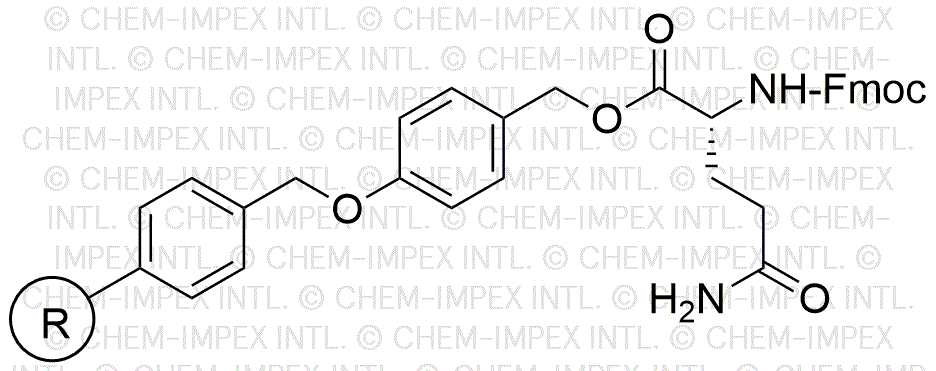Na-Fmoc-L-glutamine 4-alkoxybenzyl alcohol is widely utilized in research focused on:
- Peptide Synthesis: This compound serves as a protecting group in peptide synthesis, allowing for the selective modification of amino acids while preventing unwanted reactions. This is crucial for creating complex peptides in pharmaceutical research.
- Drug Development: Its role in drug design is significant, as it aids in the development of peptide-based therapeutics, which are increasingly important in treating various diseases, including cancer and diabetes.
- Bioconjugation: The compound is used in bioconjugation processes, where it helps attach biomolecules to surfaces or other molecules, enhancing the efficacy of drug delivery systems.
- Research in Neuroscience: It is applied in studies related to neurotransmitter pathways, where modifications of glutamine can help in understanding neurological disorders and developing targeted treatments.
- Analytical Chemistry: This chemical is utilized in analytical methods to study protein interactions and stability, providing insights that are essential for both academic research and industrial applications.
General Information
Properties
Safety and Regulations
Applications
Na-Fmoc-L-glutamine 4-alkoxybenzyl alcohol is widely utilized in research focused on:
- Peptide Synthesis: This compound serves as a protecting group in peptide synthesis, allowing for the selective modification of amino acids while preventing unwanted reactions. This is crucial for creating complex peptides in pharmaceutical research.
- Drug Development: Its role in drug design is significant, as it aids in the development of peptide-based therapeutics, which are increasingly important in treating various diseases, including cancer and diabetes.
- Bioconjugation: The compound is used in bioconjugation processes, where it helps attach biomolecules to surfaces or other molecules, enhancing the efficacy of drug delivery systems.
- Research in Neuroscience: It is applied in studies related to neurotransmitter pathways, where modifications of glutamine can help in understanding neurological disorders and developing targeted treatments.
- Analytical Chemistry: This chemical is utilized in analytical methods to study protein interactions and stability, providing insights that are essential for both academic research and industrial applications.
Documents
Safety Data Sheets (SDS)
The SDS provides comprehensive safety information on handling, storage, and disposal of the product.
Product Specification (PS)
The PS provides a comprehensive breakdown of the product’s properties, including chemical composition, physical state, purity, and storage requirements. It also details acceptable quality ranges and the product's intended applications.
Certificates of Analysis (COA)
Search for Certificates of Analysis (COA) by entering the products Lot Number. Lot and Batch Numbers can be found on a product’s label following the words ‘Lot’ or ‘Batch’.
*Catalog Number
*Lot Number
Certificates Of Origin (COO)
This COO confirms the country where the product was manufactured, and also details the materials and components used in it and whether it is derived from natural, synthetic, or other specific sources. This certificate may be required for customs, trade, and regulatory compliance.
*Catalog Number
*Lot Number
Safety Data Sheets (SDS)
The SDS provides comprehensive safety information on handling, storage, and disposal of the product.
DownloadProduct Specification (PS)
The PS provides a comprehensive breakdown of the product’s properties, including chemical composition, physical state, purity, and storage requirements. It also details acceptable quality ranges and the product's intended applications.
DownloadCertificates of Analysis (COA)
Search for Certificates of Analysis (COA) by entering the products Lot Number. Lot and Batch Numbers can be found on a product’s label following the words ‘Lot’ or ‘Batch’.
*Catalog Number
*Lot Number
Certificates Of Origin (COO)
This COO confirms the country where the product was manufactured, and also details the materials and components used in it and whether it is derived from natural, synthetic, or other specific sources. This certificate may be required for customs, trade, and regulatory compliance.

